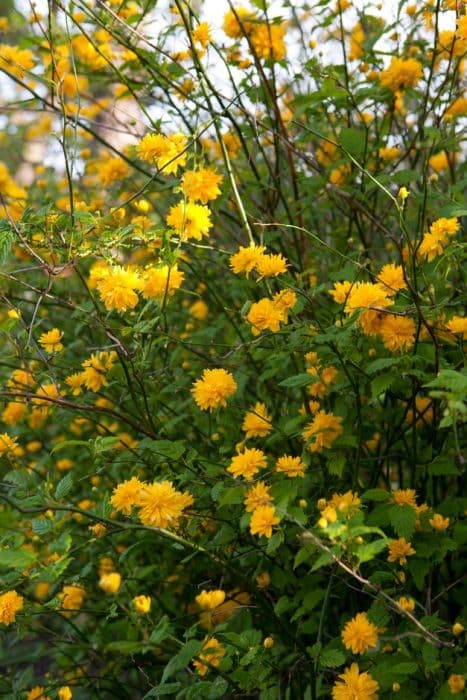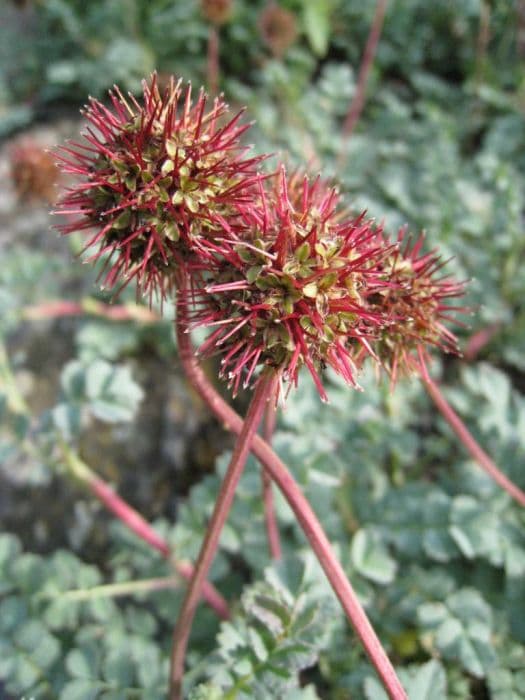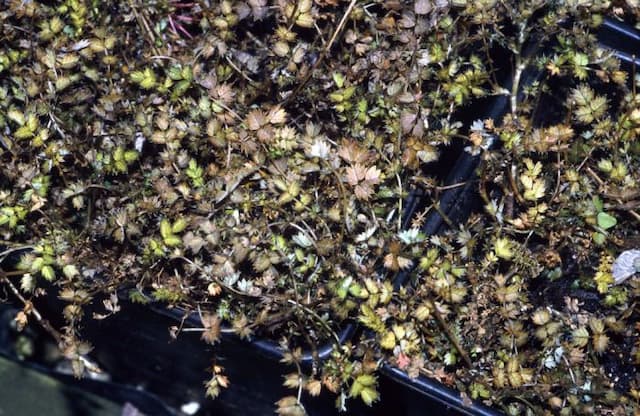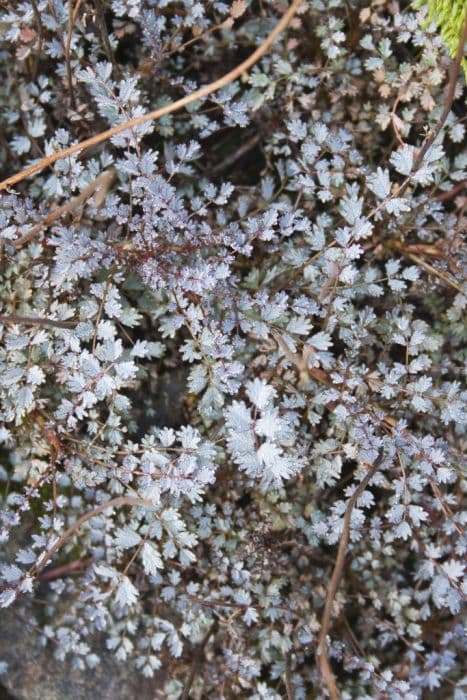Japanese Kerria Kerria japonica 'Pleniflora' (d)

ABOUT
Kerria japonica 'Pleniflora', commonly known as the Double-Flowered Japanese Rose, is an ornamental shrub known for its vibrant spring blooms. It features an abundance of fully double, sunny yellow flowers that resemble small pom-poms or rosettes. The blooms stand out against a backdrop of bright green, slender, and arching stems that offer a pleasing contrast. The foliage consists of toothed leaves that are lush and light green, turning to a soft yellow color in the fall. This deciduous shrub presents a graceful, fountain-like form with a natural, informal appearance that can add whimsy to any garden setting. The Double-Flowered Japanese Rose has stems that are somewhat unique compared to other flowering shrubs, as they maintain a green hue throughout the year, adding winter interest to the landscape even when the leaves have fallen.
About this plant
 Names
NamesFamily
Rosaceae.
Synonyms
Japanese Kerria, Double-Flowered Japanese Rose, Bachelor's Buttons, Easter Rose, Japanese Rose.
Common names
Kerria japonica var. pleniflora, Rubus japonicus var. pleniflorus, Rubus japonicus f. pleniflorus.
 Toxicity
ToxicityTo humans
The Japanese rose is not known to be toxic to humans. There are no widely recognized symptoms of poisoning from ingesting this plant, as it is generally considered non-toxic. Therefore, it is unlikely to cause any significant consequences if ingested by humans.
To pets
The Japanese rose is not known to be toxic to pets. Ingesting parts of this plant typically does not result in poisoning or adverse health effects for animals such as cats and dogs. As a result, it is generally considered safe for pets, and no specific symptoms of poisoning are expected to occur from ingestion.
 Characteristics
CharacteristicsLife cycle
Perennials
Foliage type
Deciduous
Color of leaves
Green
Flower color
Yellow
Height
5-9 feet (1.5-2.7 meters)
Spread
6-8 feet (1.8-2.4 meters)
Plant type
Shrub
Hardiness zones
4-9
Native area
China, Japan
Benefits
 General Benefits
General Benefits- Ornamental value: Japanese Kerria 'Pleniflora' has showy, double yellow flowers that add visual interest to gardens in the spring.
- Easy to grow: It is known for being low maintenance and adapts well to a variety of soil conditions.
- Shade tolerance: This plant can thrive in partial shade, making it suitable for understory planting or north-facing gardens.
- Seasonal interest: Besides its spring blooms, it exhibits bright green stems that can provide winter color in otherwise barren landscapes.
- Erosion control: Its root system can help stabilize soil on slopes, reducing the risk of erosion.
- Wildlife attraction: Although it does not have significant wildlife benefits, it can occasionally attract pollinators such as bees during its blooming period.
- Drought tolerance: Once established, Japanese Kerria 'Pleniflora' can tolerate periods of drought.
- Deer resistance: It is generally resistant to deer, which can be particularly important in areas where deer grazing is a problem for gardeners.
 Medical Properties
Medical PropertiesThis plant is not used for medical purposes.
 Air-purifying Qualities
Air-purifying QualitiesThis plant is not specifically known for air purifying qualities.
 Other Uses
Other Uses- Kerria japonica 'Pleniflora', commonly known as Japanese kerria, can be used in thematic gardens for cultural education, as it originates from China and Japan, introducing visitors to Asian flora.
- Its bright yellow flowers are suitable for dye extraction, which can be employed in textile dyeing workshops or traditional dye-making demonstrations.
- The strong and flexible branches of Japanese kerria can be used in basketry and weaving crafts, providing natural materials for artisan projects.
- In ornamental topiaries, the stems can be trained and shaped while the plant is young, making it a versatile choice for formal garden design.
- Japanese kerria's dense foliage can provide shelter and habitat for small garden wildlife such as songbirds and beneficial insects.
- The plant can be used in erosion control on sloped gardens due to its spreading habit and propensity to form a dense thicket.
- Its tolerance for urban conditions makes it a good candidate for planting in roadside verges or public spaces that experience higher pollution levels.
- Japanese kerria, with its bright spring blooms, can also serve as a natural marker or highlight within a garden to signify the change of seasons.
- The plant's arching stems can be used in garden design to create a naturalistic or ‘wild garden’ look, blending seamlessly with informal landscapes.
- Japanese kerria wood, being somewhat sturdy, can also be used for making small garden stakes or supports for other plants.
Interesting Facts
 Feng Shui
Feng ShuiThe Japanese Rose is not used in Feng Shui practice.
 Zodiac Sign Compitability
Zodiac Sign CompitabilityThe Japanese Rose is not used in astrology practice.
 Plant Symbolism
Plant Symbolism- Rejuvenation: Kerria japonica 'Pleniflora', commonly known as Japanese Rose, typically blooms in the spring after a period of winter dormancy, symbolizing the idea of renewal and the emergence of life after a period of quiet or rest.
- Resilience: The Japanese Rose is known for its hardiness and ability to thrive in a variety of conditions, representing resilience and the ability to withstand challenges.
- Cheerfulness: With its bright yellow flowers, the Japanese Rose is often associated with joy and happiness, bringing a cheerful presence to the garden.
- Longevity: As a plant that can live and keep blooming for many years, the Japanese Rose is sometimes used to symbolize longevity and enduring life.
 Water
WaterThe Japanese rose should be watered deeply once a week, providing about 1 to 1.5 gallons of water for each plant. During hot or dry periods, monitoring the soil moisture is crucial, and additional water may be needed to maintain consistent soil moisture without waterlogging. Water at the base of the plant to minimize leaf wetness, reducing the risk of fungal diseases. In the winter, reduce watering frequency as the plant's water requirements decrease.
 Light
LightThe Japanese rose thrives best in full sun to partial shade. Ideally, it should receive at least four hours of direct sunlight every day, with dappled shade during the hottest part of the afternoon. Placing it in a spot that gets morning sunlight and afternoon shade can help promote healthy growth and abundant flowering.
 Temperature
TemperatureThe Japanese rose is a hardy plant that can tolerate a wide range of temperatures, generally surviving between 5°F and 100°F. Optimal growing temperatures are between 60°F and 80°F. This shrub can withstand a frost and is suited for USDA hardiness zones 4 to 9.
 Pruning
PruningPrune the Japanese rose after flowering to maintain its shape and encourage bushiness. Typically, this means cutting back the stems that have bloomed, and some gardeners recommend thinning out older canes to rejuvenate the plant. Annual pruning is beneficial, and the best time is late winter or early spring before new growth begins.
 Cleaning
CleaningAs needed
 Soil
SoilJapanese Rose thrives best in a well-draining, loamy soil with a pH range of 6.0 to 7.5. A mix of two parts garden soil, one part peat moss or well-rotted compost, and one part sharp sand or perlite creates an ideal environment for this plant to flourish.
 Repotting
RepottingJapanese Rose rarely needs repotting as it is typically grown as a landscape plant. If grown in containers, repotting every 2 to 3 years should be sufficient, preferably in the spring after blooming.
 Humidity & Misting
Humidity & MistingJapanese Rose prefers moderate humidity but is quite adaptable and does not require specific humidity conditions. As long as the plant is not in an overly dry environment, it should do well.
 Suitable locations
Suitable locationsIndoor
Ensure bright indirect light, well-draining soil, and room to grow.
Outdoor
Plant in partial shade to full sun and well-draining soil.
Hardiness zone
4-9 USDA
 Life cycle
Life cycleKerria japonica 'Pleniflora', commonly known as Japanese Kerria or Easter Rose, arises from a dormant state in early spring with the emergence of green shoots from its root system. Its slender, green, arching branches soon develop toothed, bright green leaves and the plant enters a rapid vegetative growth phase. By mid to late spring, the plant reaches maturity and produces abundant double, pom-pom like yellow flowers that attract pollinators. After flowering, the plant sets seeds, which are rarely viable due to the double-flowered characteristics of this ornamental cultivar. During the summer, it continues to grow vegetatively and may require pruning to maintain shape and encourage air circulation. Finally, in the fall, Japanese Kerria enters dormancy as the leaves yellow and drop, with the plant overwintering via its root system until the following spring.
 Propogation
PropogationPropogation time
Early spring
Kerria japonica 'Pleniflora', commonly known as double-flowered Japanese rose, is most effectively propagated through softwood cuttings. This is typically done in late spring to early summer. To propagate, one must choose a healthy, non-flowering stem and cut a piece that is about 4 to 6 inches (10 to 15 centimeters) long, ensuring that there are several leaves on the cutting. The bottom leaves are removed, and the cut end is dipped in rooting hormone to encourage root development. The cutting is then inserted into a pot filled with a mixture of peat and perlite or a similar well-draining rooting medium. After which, the pot is placed in a warm, bright area without direct sunlight and kept moist until roots have formed, which usually takes a few weeks. Once the cuttings have rooted, they can be transplanted into individual pots and grown on before transferring them to their final location.









